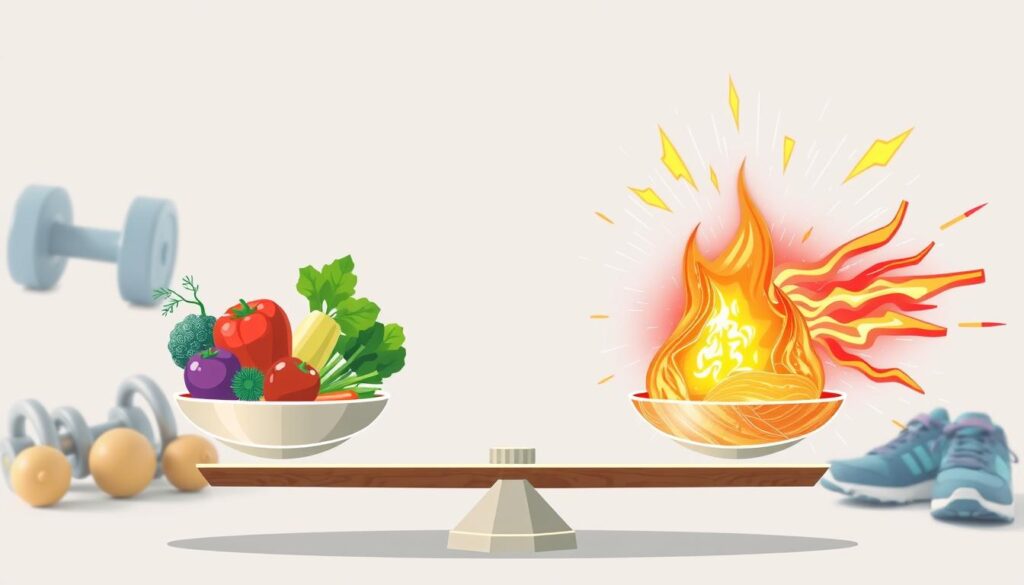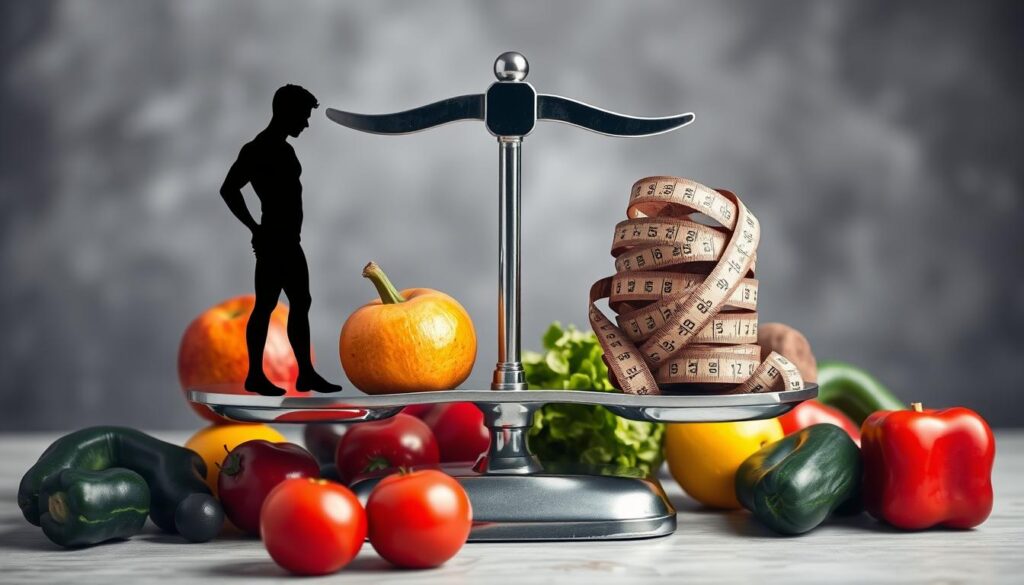Losing weight can be tough, but you don’t have to lose your muscle. The right steps can help you lose fat and keep your muscle. This guide will show you how to change your body in a good way.
To lose weight, you need to eat less and exercise more. But losing fat without losing muscle is all about balance. Losing weight slowly is better for keeping your muscle, not losing it fast.
By working on your body composition, you can lose fat and keep or grow muscle. This guide will explain the science behind losing fat without losing muscle. It will cover nutrition, training, and tips to get the results you want.
Key Takeaways
- Gradual weight loss is more effective in preserving muscle mass compared to rapid or extreme calorie restriction.
- Balanced nutrition and exercise are crucial for achieving fat loss without compromising muscle mass.
- Resistance training is essential for retaining lean muscle during the weight loss process.
- Optimal protein intake and strategic meal timing can help maintain muscle mass while losing fat.
- Tracking progress and making adjustments based on your body’s response is key to long-term success.
Understanding Body Composition and Weight Loss Fundamentals
Understanding your body composition is key for weight loss. It’s about the mix of fat, muscle, and other body parts. Knowing the difference between fat and muscle helps you reach your health goals.
Difference Between Fat Mass and Lean Mass
Fat mass is the fat in your body. Lean mass includes muscles, bones, and organs. A good balance between these is vital for health and weight control.
White fat stores energy, while brown fat burns calories. This makes brown fat important for losing weight.
Role of Body Composition in Health
Your body composition affects your health and how long you live. Too much fat mass raises the risk of heart disease and diabetes. But, keeping lean mass helps you stay strong and mobile.
Metabolic Adaptation During Weight Loss
When you lose weight, your body changes. This can slow down your metabolism and hormone levels. To fight this, try strength training, managing stress, and eating enough protein.
“Achieving fat loss without muscle loss requires a strategic approach that takes into account your body composition and the complex interplay between diet, exercise, and metabolic factors.”
The Science Behind Fat Loss Without Muscle Loss
Many people want to lose fat without losing muscle. The trick is to eat enough protein and not too many calories. This helps keep your muscles strong.
When you eat fewer calories, your body might use muscle for energy. But, eating enough protein helps build muscle instead. This stops your body from losing muscle.
Working out with weights is also key. It tells your body to build muscle. Eating protein and working out helps you lose fat without losing muscle.
Hormones like leptin and ghrelin help you feel full. They help you eat the right amount of food when you’re trying to lose weight.
Genetics can affect how you lose weight. But, exercise can help you fight against obesity. Knowing how to lose fat without losing muscle helps you make a plan that fits you.
| Statistic | Insight |
|---|---|
| Older adults with obesity have around 20% more thigh muscle mass and around 2 times more muscle lipid content compared to older adults with normal weight. | Excess body fat can adversely affect muscle quality and function, highlighting the importance of maintaining a healthy body composition. |
| In persons with normal weight, fat-free mass loss often exceeds 35% of total weight loss, while in persons overweight or obese, fat-free mass contributes only around 20-30% to total weight loss. | Individuals with obesity tend to lose a smaller proportion of muscle mass during weight loss compared to those with normal weight, emphasizing the need for a tailored approach. |
| Research studies have shown that weight loss typically comprises between 20–40% of fat-free mass (FFM). | Maintaining muscle mass during weight loss is crucial, as fat-free mass includes skeletal muscle, which plays a vital role in glucose metabolism and overall health. |
Understanding how to lose fat without losing muscle is key. A good plan includes eating enough protein, working out, and managing calories. This helps you reach your fitness goals while keeping your muscle.
Essential Nutritional Strategies for Body Recomposition
To get a balanced body, you need to lose fat and gain muscle at the same time. This is called “body recomposition.” We will look at the best ways to eat to help you achieve this goal.
Optimal Protein Intake Requirements
Protein is key for keeping and growing muscle. Eat 20-40 grams of good protein at each main meal. Your daily protein should be 0.64 to 1.4 grams for every pound of your weight.
Eating more protein, over 25% of your calories, helps keep muscle while losing fat.
Macronutrient Balance for Muscle Preservation
It’s important to eat the right mix of nutrients to keep muscle. Eat 55% carbs, 15% protein, and 30% healthy fats. This mix gives your body what it needs to grow muscle and lose fat.
Strategic Meal Timing and Frequency
When you eat matters a lot for body recomposition. Eating protein-rich foods all day, especially after working out, helps your muscles recover and grow. Try to eat 3-5 meals or snacks that are full of nutrients, spread out to keep your blood sugar steady.
Using these nutritional strategies will help you on your way to a better body. Remember, it takes time, patience, and a complete approach to succeed in body recomposition.
Effective Training Methods for Muscle Retention
When you want to lose fat but keep your muscles, your workout plan is key. You need to mix resistance training with smart cardio exercise. Resistance training is better than cardio for keeping your muscle mass when you’re losing weight.
High-Intensity Interval Training (HIIT) is great for losing fat without losing muscle. It works by switching between hard exercise and rest. This helps you burn calories well and makes your muscles stronger.
Make your workouts harder over time to keep your muscles growing. This is called progressive overload. It’s important for keeping your lean muscle mass as you lose fat.
| Training Approach | Benefits for Muscle Retention |
|---|---|
| Resistance Training | Maintains and builds muscle mass during fat loss |
| High-Intensity Interval Training (HIIT) | Boosts fat loss while preserving muscle |
| Gradual Increase in Workout Intensity | Challenges muscles and supports muscle growth |
By using these training methods, you can lose fat and keep your muscle mass. The secret is to keep challenging your body. Also, make sure to give your muscles the right food and rest to grow.

The Role of Protein in Preserving Lean Muscle Mass
Keeping muscle mass while losing weight is important for health and metabolism. High-quality protein is key. It helps keep your lean muscle while you lose fat.
High-Quality Protein Sources
Choose lean and complete proteins like lean meats, fish, eggs, and dairy. Soy, legumes, and quinoa are good plant-based options. Eat a variety of these foods all day.
Protein Timing and Distribution
Timing your protein is important. Eat it within 45 minutes after working out to help muscles recover and grow. Spread your protein intake over meals and snacks, not just one big meal.
Supplementation Guidelines
If you don’t get enough protein, think about supplements. Whey, casein, and plant-based powders can help. Chromium picolinate might also help with losing weight and keeping muscle.
| Protein Source | Protein Content (per 100g) |
|---|---|
| Chicken Breast | 31g |
| Salmon | 25g |
| Eggs | 13g |
| Lentils | 9g |
| Quinoa | 4g |
Using these tips can help you keep lean muscle while losing fat. A balanced protein plan, along with exercise, is key to reaching your body goals.
Creating the Perfect Calorie Deficit
It’s hard to lose fat without losing muscle. The trick is to cut calories a bit to lose fat but keep your muscle. This keeps your metabolism and body shape good.
The right calorie deficit is about 10% of what you burn daily. This slow way of losing weight is steady. It stops your body from breaking down muscle.
Keep an eye on your weight, body fat, and muscle. Tracking these helps you adjust your diet and workouts. This keeps your metabolic rate and energy balance in check.
Don’t try crash diets or extreme calorie-restricted plans. They can make you lose muscle. This hurts your sustainable weight loss goals later on.
| Metric | Recommended Range |
|---|---|
| Calorie Deficit | 10% of total daily energy expenditure |
| Protein Intake | 0.8-1.6 grams per kilogram of body weight |
| Resistance Training Frequency | 3-4 times per week |
| Sleep Duration | 7-8 hours per night |
Stick to these tips for a slow, healthy weight loss. You’ll reach your fat loss goals without losing muscle or harming your health.

Resistance Training Protocols for Muscle Preservation
To keep your muscles while losing fat, you need a good plan. Resistance training helps keep and grow lean muscle while burning fat.
Workout Frequency and Volume
Do resistance training 2-3 times a week. This targets all big muscle groups. It’s good for muscle growth and recovery.
Start with light weights and do more reps. Then, slowly add more weight to challenge your muscles.
Exercise Selection and Programming
Choose exercises that work many muscles at once. Squats, deadlifts, pull-ups, and bench press are great. They help build and keep muscle.
Make sure to include these exercises in your routine. Don’t just do small exercises.
Recovery Strategies
Rest well to keep your muscles when eating less. Give your muscles 48 hours to rest between workouts. This helps them grow back stronger.
Get enough sleep, drink water, and eat enough protein. This helps your muscles repair and grow.
By following these tips, you can lose fat and keep or grow muscle. A mix of good food, exercise, and rest is key to your goals.
| Resistance Training Recommendations | Details |
|---|---|
| Workout Frequency | 2-3 times per week |
| Targeted Muscle Groups | All major muscle groups |
| Exercise Selection | Compound exercises (e.g., squats, deadlifts, pull-ups, bench press) |
| Recovery Time | 48 hours between workouts for the same muscle group |
| Nutrition and Hydration | Adequate protein intake, proper sleep, and staying hydrated |
“To maintain muscle mass while losing fat, it’s recommended to strike a balance between exercise and calorie restriction.”
Common Mistakes to Avoid During Fat Loss
Getting rid of fat without losing muscle is tricky. But, by avoiding common mistakes, you can keep your muscle. Let’s look at some mistakes to avoid on your fat loss journey.
First, don’t cut calories too much. A little calorie deficit is good for losing fat. But, too much can make you lose muscle. Go for a small, steady calorie cut to lose fat without losing muscle.
Also, don’t skip resistance training for too much cardio. Strength training helps keep and grow muscle when losing fat. Mix strength training with cardio for a balanced workout plan.
- Make sure you eat enough protein to keep and fix muscle.
- Stay away from crash diets and fads. They promise quick weight loss but often lead to muscle loss and aren’t lasting.
- Focus on slow, steady fat loss instead of quick, short-term weight loss that’s hard to keep up.
Lastly, keep going with your plan and look at long-term progress more than short-term changes. Celebrate small wins and believe in the process as you aim for weight loss without muscle loss.
“The key to successful fat loss is not just about burning calories, but about preserving muscle mass and maintaining a healthy, sustainable lifestyle.”
Tracking Progress and Making Adjustments
To lose fat without losing muscle, you need a smart plan. Watch your body changes with body composition tests and performance checks. This helps you stay on track.
Body Composition Measurements
Use tools like DEXA scans or bioelectrical impedance to see fat and muscle changes. These tools give you important info for your diet and workout plans.
Performance Metrics
- Watch how strong and fit you get in the gym. It shows you’re keeping muscle while losing fat.
- See how your workouts change. This shows how well you’re building muscle.
Adjustment Strategies
Change your diet and workouts if needed. If you’re not losing weight or losing muscle, it’s time to adjust. Be flexible and listen to your body to keep losing fat and keeping muscle.
| Metric | Ideal Range | Action Steps |
|---|---|---|
| Weekly Weight Loss | 1-2 lbs | Adjust calorie intake and/or exercise volume as needed |
| Body Fat Percentage | 0.5-1% monthly decrease | Evaluate nutrition and training plan for optimization |
| Strength Improvements | Maintain or increase lifts | Ensure adequate protein and recovery time |
Keep a close eye on your progress and make changes when needed. This way, you can reach your fat loss goals without losing muscle.
Conclusion
Getting rid of fat without losing muscle is complex. It needs careful watching of what you eat, how you train, and your lifestyle. Eating enough protein, doing resistance training, and keeping a calorie deficit helps keep your muscles while losing fat.
On your body recomposition path, watch your progress closely. Make changes when needed. Always choose long-term health and sustainable weight loss over quick fixes. Talk to a nutrition or fitness expert to get a plan that fits your goals.
The secret to fat loss without muscle loss is balance. It’s about feeding your body, working your muscles, and making slow, lasting changes. This way, you can become a healthier, more confident you.


A Life-Changing Experience with This Weight Loss Supplement (Nagano Tonic)
I’ve always struggled with finding a weight loss solution that actually works for me. Like many, I’ve tried numerous diets, exercise routines, and supplements over the years—some worked for a short time, but nothing ever gave me long-term results. That was until I decided to try the weight loss supplement I found : Link to the Supplement.
From the moment I started using it, I noticed a difference. Not only did I feel more energized, but my cravings also became more manageable. The best part? I started seeing results much quicker than I anticipated! Over the course of just a few weeks, I noticed a significant reduction in belly fat and overall weight loss that I hadn’t been able to achieve before.
What makes this supplement stand out from all the others I’ve tried is how it supports me in my daily routine without any jitters or energy crashes. I’m able to stay focused and motivated, which has made it easier to stay on track with my diet and exercise plan.
This product truly exceeded my expectations, and I feel more confident and healthier than ever before. If you’re struggling with your weight loss journey like I was, I highly recommend giving this supplement a try. It’s been a game-changer for me, and I’m sure it can work wonders for you too!
Contant Them on email .. tonicnagano50@gmail.com
I’ve tried so many weight loss products over the years, but nothing worked like this supplement! Since I started using it, I’ve noticed a big difference in my energy levels and appetite control. In just a few weeks, I’ve lost weight and feel so much better. It’s been easy to stick with, and the results speak for themselves. Highly recommend this to anyone looking to make a real change!
wasn’t sure what to expect, but this weight loss supplement has really impressed me! After just a few weeks of use, I’ve already dropped a few pounds and feel more motivated to stay active. It’s helped curb my cravings and boosted my energy throughout the day. I’m excited to keep going and see even better results. Definitely worth trying!
Reach them on tonicnagano50@gmail.com